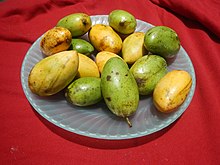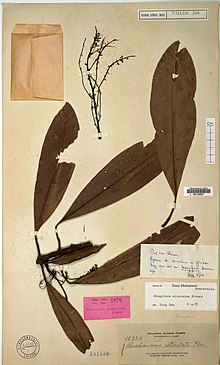| Mangifera altissima | |
|---|---|

| |
| Ripe and unripe pahutan mangoes from the Philippines | |

| |
| Herbarium specimen of Mangifera altissima | |
| Scientific classification | |
| Kingdom: | Plantae |
| Clade: | Tracheophytes |
| Clade: | Angiosperms |
| Clade: | Eudicots |
| Clade: | Rosids |
| Order: | Sapindales |
| Family: | Anacardiaceae |
| Genus: | Mangifera |
| Species: | M. altissima
|
| Binomial name | |
| Mangifera altissima | |
| Synonyms[2] | |
|
Mangifera mucronulata Blume | |
Mangifera altissima (commonly known as pahutan, paho, or pajo), is a species of mango native to the Philippines and surrounding regions in Indonesia, Malaysia, Papua New Guinea and the Solomon Islands. It is not grown commercially but is harvested from the wild in the Philippines. It has small fruits that are pale yellow when ripe and are very sweet, though much more fibrous than commercially cultivated Mangifera indica species like Carabao mangoes. It is threatened by habitat loss.[2][3][1][4]
In the Philippines, pahutan mangoes are eaten ripe as is, or eaten with rock salt or used in salads when unripe.[5]
See also
[edit]- Mangifera caesia (mangga wani)
References
[edit]- ^ a b Barstow, M. (2020). "Mangifera altissima". IUCN Red List of Threatened Species. 2020: e.T31380A61525941. doi:10.2305/IUCN.UK.2020-3.RLTS.T31380A61525941.en. Retrieved November 17, 2021.
- ^ a b "Mangifera altissima Blanco". Plants of the World Online. The Trustees of the Royal Botanic Gardens, Kew. n.d. Retrieved August 23, 2020.
- ^ "Pahutan". Merriam-Webster. Retrieved August 5, 2014.
- ^ Western, Peter Jansen (1920). The Mango. Manila: Bureau of Printing.
- ^ "Not Quite the Mango We Know". Our Philippine Trees. April 3, 2009. Retrieved March 5, 2021.

